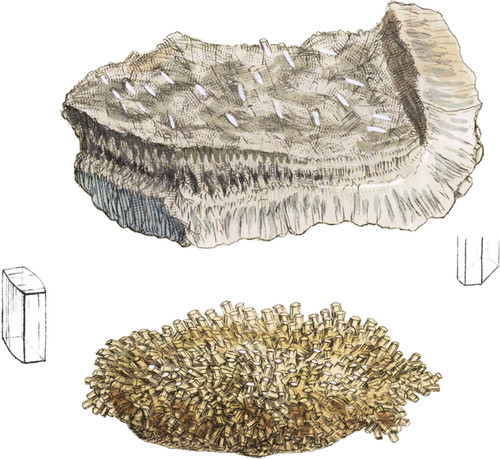 Enlarge
Enlarge
British Mineralogy
Stilbite, or Foliated Zeolite
- Class 2. Earths.
- Order 1. Homogeneous.
- Gen. 4. Silex.
- Spec. Stilbite.
- Syn.
- Stilbite. Haüy, 3. 161. Wern. Catal. 267.
- Blattriger Zeolith. Emmerl. 1. 204.
- Foliated Zeolite. Thomson, 4. 316.
- Zeolith. Kirw. 1. 278.
- Zeolithe nacrée. Lameth. 2. 305.
British specimens of Stilbite are found chiefly in Scotland and Ireland, It may generally be known by the laminated texture of its crystals, which are often so small as scarcely to be distinguished without the assistance of a magnifying glass. The specimens figured came from Strontian. The crystals of the upper one are very small and confused, excepting a few that stand higher than the rest, and are scattered about the specimen. The other side of the specimen consists of Carbonate of Lime in six-sided prisms, with flat ends, being what is commonly called truncated—see the right hand upper outline.
These crystals of Carbonate of Lime must not be confounded with those of the Stilbite. It is somewhat remarkable that, of specimens which come from Strontian, Carbonate of Lime frequently occupies one side and Stilbite the other.
The crystals of Stilbite here figured, at first sight appear like six-sided prisms; but in fact are only four-sided. Two sides are generally smooth and flat, showing the laminated texture and internal pearly lustre; and the other two are striated, somewhat convex, and rather irregularly bevilled, often giving the crystal a six-sided appearance. The summits have also the appearance of being truncated, and have various parallel bevillings on them, giving them a convexity rather more prominent than that on the sides. They are somewhat transparent, and very little coloured.
The Carbonate of Lime and Stilbite meet, as it were, back to back, in the midst of the specimen. There is, however, a space which perfectly distinguishes them, the Stilbite forming irregular spiculæ meeting those of the Carbonate of Lime.
The lower specimen is yellower than usual, and the crystals are very distinct though small.

